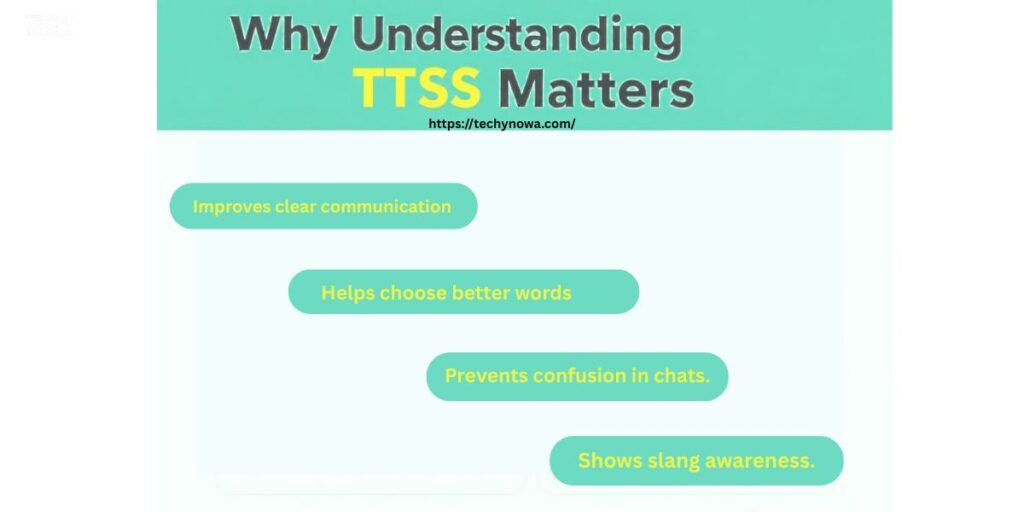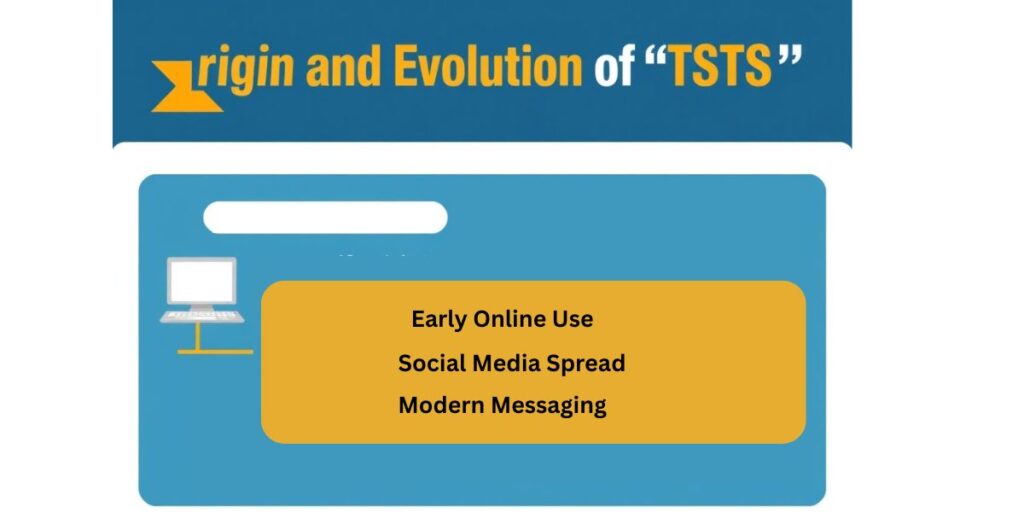TSTS is a popular texting abbreviation that often confuses new users. It stands for Too Soon To Say, showing uncertainty in a polite way. People use it in chats, social media and casual messages. In 2025, this slang still fits modern digital talk perfectly. Knowing its meaning helps you reply with the right tone. Let’s explore what TSTS means and the best alternatives to use today.
What Does TSTS Mean in Text?
It stands for Too Soon To Say. It is used when someone is not ready to give a clear answer. People use it to sound honest without making promises. It shows they need more time before deciding or responding. For example, “Are you getting the job?” , “TSTS, still waiting for the call.”
This phrase is common in casual chats and social media. It helps keep conversations polite and open-ended. TSTS can also reduce pressure in uncertain talks. It is a simple way to show you’re unsure but still engaged. Many people use it daily when answers are not final yet.
Related guide: What Does RS Mean In Text? Complete Guide With Polite Alternatives 2025
Is TSTS Formal or Informal?
It is mostly an informal abbreviation used in casual chats. You shall often see it in texts between friends or on social media. It is too relaxed for business or professional emails. In formal settings, it’s better to write the full phrase Too Soon To Say. For example, texting a friend “TSTS about the trip plans sounds natural and friendly.
In a workplace or school email, using TSTS can seem unprofessional. Formal messages require complete words and clear language. Writing It is too soon to say sounds more respectful and polished. The tone depends on who you are talking to and the situation. So, keep TSTS for casual talks and skip it in official ones.
Related guide: TM In Text Messages: Meaning, Usage, And Best Alternatives 2025
When to Use TSTS in a Conversation
You can use TSTS when you are unsure about something. It is perfect for moments when answers need more time. For example, if a friend asks, “Will you get the job?” you can say, “TSTS, still waiting for the call.” It keeps your reply polite and calm. This shows you’re being honest without rushing your response.
Use TSTS in both personal and casual talks. It fits well in texts, group chats or social media comments. People use it to show patience and thoughtfulness. For example, TSTS about the trip plans, not confirmed yet. It helps you sound clear and respectful while staying friendly.
✅ Example Situations:
You can use TSTS when the answer is not ready yet. It is great for things like job updates, travel plans or event dates. For example, “TSTS, I shall know tomorrow.” It keeps the talk polite and clear. This shows you are honest and not avoiding the question.
Related guide: EYP Meaning Slang: The Complete 2025 Guide To Its Usage, Definition & Alternatives
Why Understanding TSTS Matters
It helps you avoid confusion in digital chats. It shows when someone is unsure but still polite. This small phrase keeps conversations clear and respectful. Using it right builds better online communication. For example, saying “TSTS, I shall check later” sounds thoughtful instead of dismissive.

It also helps you read tone correctly. It can show hesitation, honesty, or careful thinking. Misreading it might make a message seem cold or rude. That is why understanding context is important in texting. For instance, “TSTS about the plan” shows the person needs time before deciding.
Polite, Professional and Casual Alternatives to TSTS
You can use other phrases instead of TSTS depending on tone. For polite chats, say I’m not sure yet. In professional messages, use It is still under review. For casual talks, try “Too early to tell or Not decided yet.
✅ Polite Alternatives (Great for emails or semi-formal settings):
Polite alternatives help you sound respectful and clear. You can use phrases like I’m not certain yet or still thinking about it. These show honesty without sounding rude. They fit well in polite or friendly email replies. For example, “I’m not sure yet, but I shall update you soon” keeps the tone soft.
✅ Professional Alternatives (Best for workplace or business):
It keeps your message formal and confident. You can say “It is still under consideration” or “We are reviewing the details.” These phrases sound responsible and clear. They work well in office chats or client emails. For instance, “It is under review, I’ll share results soon” sounds professional and polite.
✅ Casual Alternatives (Perfect for texting or friendly chats):
It makes your messages sound relaxed and natural. Try using “Too early to tell” or “Not sure yet.” These are simple and friendly ways to express uncertainty. They fit perfectly in everyday texting or group chats. For example, “TSTS haha, I’ll see later” keeps the tone easygoing.
Tone Matters: Choosing the Right Alternative
Your tone changes how your message feels. A polite tone shows respect and care. A casual tone feels friendly and relaxed. Choosing the right tone helps your message sound natural and clear.
💼 In the Workplace:
Using TSTS at work keeps communication clear and professional. It shows you need more time before confirming something. This helps avoid giving wrong information. It also shows honesty and patience in decision-making. For example, TSTS on the project results, sounds polite and responsible.
💬 In Friendly Conversations:
Friends often use “TSTS” when they are unsure but casual. It keeps the chat light and open. This phrase avoids pressure or quick answers. It is perfect for relaxed, friendly talks. For instance, “TSTS if we are meeting tonight” sounds easygoing and real.
💖 In Sensitive or Emotional Topics:
TSTS can show care and thoughtfulness in deep talks. It gives space when emotions are involved. Using it helps avoid sounding harsh or rushed. It is a gentle way to express uncertainty. For example, “TSTS how I feel about that” sounds calm and respectful.
Avoiding Misuse of TSTS
Many people use TSTS without understanding its tone. It shows uncertainty, not avoidance or disinterest. Using it in serious or emotional talks may seem careless. Always check if the situation needs a clear answer instead. For example, saying “TSTS about your job offer is fine, but not “TSTS about your health.
TSTS should fit friendly or light chats. In professional or sensitive topics, choose polite alternatives. Try saying ,I’m not sure yet, instead of TSTS in formal cases. This keeps your message clear and respectful. Proper use shows good communication sense and awareness.
Cultural and Global Considerations
| Region / Culture | How “TSTS” Is Understood | Communication Tip |
| North America | Seen as casual and friendly. | Use in light chats or online comments. |
| Europe | Understood but less common. | Explain meaning if others seem unsure. |
| Asia | May confuse non-native speakers. | Use full form “Too Soon To Say” for clarity. |
| Middle East | Not widely recognized in text slang. | Avoid formal or business messages. |
| Global Online Use | Gaining popularity among Gen Z. | Always match tone and audience. |
Why Readers Should Consider Using Alternatives to TSTS
Sometimes, using it can sound unsure or unclear in a chat. It may confuse people who do not know the slang well. Choosing clearer words helps your message sound more confident. For example, saying “I’m not sure yet” feels more natural in formal talk. Clear language always builds better understanding online.
Different situations need different tones. Using the same phrase everywhere can seem lazy or repetitive. Alternatives to TSTS make your replies more personal and expressive. For example, Let’s wait and see sounds friendly and open. Picking the right phrase helps your messages match the moment perfectly.
15 Ideal Reply Examples Instead of “TSTS”
- I’m not sure yet.
- Let’s wait and see.
- Too early to tell right now.
- I shall know soon.
- Still thinking about it.
- Hard to say at the moment.
- I shall update you later.
- Not clear yet.
- Give it some time.
- We shall find out soon.
- I need more info first.
- Let’s see how it goes.
- I can not decide yet.
- Still working on it.
- Time will tell.
Origin and Evolution of “TSTS”
It began appearing in online chats in the early 2010s. It was first used to mean Too Soon To Say during uncertain conversations. People liked it because it sounded casual and polite. Over time, it spread across texting apps, forums, and social media. For example, someone might reply to TSTS when asked about upcoming plans they are unsure of.

As online language evolved, it kept its meaning but became more versatile. It now appears in memes, tweets, and everyday digital talk. Many users use it to soften their replies without sounding rude. It shows honesty while keeping the tone friendly and short. For instance, a friend might text, Will we win the game? and get a reply, “TSTS 😅.”
Real-Life Examples of “TSTS” in Use
- In Daily Chat: Will you get the job? TSTS, still waiting for the call.
- In Group Texts: Are we meeting tonight? TSTS, depends on everyone’s schedule.
- On Social Media: Will this trend last?, TSTS 😂 only time will tell.
- In Work Messages: Will the project launch this week?TSTS, the client has not been confirmed yet.
- In Dating Chats: Do you like them? TSTS, I’m still getting to know them.
Similar Acronyms and Common Misunderstandings
Many acronyms sound similar to TSTS but mean different things. Phrases like IDK yet or TBA also show uncertainty. People often mix them up when texting quickly. TSTS sounds casual, while TBA feels more formal. For example, someone might text TSTS, let’s wait for updates instead of TBA.
Some users misunderstand TSTS as a joke or tease. They may read it as sarcasm depending on tone or context. Misreading it can cause confusion in serious talks. Always check the mood of the conversation before using it. For example, avoid using “TSTS” in emotional or sensitive discussions.
Personal Experience with “TSTS”
I first saw TSTS in a group chat with my friends. Someone asked if our trip plan was final, and another replied, “TSTS.” I had no idea what it meant then. Later, I learned it stands for Too Soon To Say. It made me realize how texting slang keeps evolving fast.
Now, I use TSTS often in casual chats. It helps me express uncertainty without sounding rude. My friends also use it when plans are not confirmed. It feels polite yet casual in tone. This small acronym makes communication quick and easy.
Frequently Asked Questions
What does TSTS mean in text?
It stands for “Too Soon To Say,” used when something isn’t certain yet.
How is TSTS used in a conversation?
You can say TSTS when someone asks about a plan or decision that is not final.
Is TSTS a new slang term?
It is not brand new, but it is gaining more use in 2025 texting and online chats.
Can I use TSTS in formal messages?
No, it is better for casual or friendly conversations, not for business use.
What are some alternatives to TSTS?
You can use IDK yet, too early to tell, or not sure for now.
Is TSTS used on social media?
Yes, it appears often on platforms like Twitter, Instagram, and Reddit.
Does TSTS have any other meanings?
Mostly it means Too Soon To Say, but context always matters.
Conclusion
TSTS is a simple way to show uncertainty in texting. It stands for Too Soon To Say. People use it in chats, social media, and casual messages. Knowing its meaning helps you respond correctly. It keeps conversations polite and clear. Using TSTS makes texting faster and easier.
There are also good alternatives to TSTS. You can use IDK yet or Too Early to Tell. Context matters when choosing the right phrase. Personal experience helps you understand its tone. TSTS is popular in 2025 digital communication. Remember to use it wisely with friends and peers.








